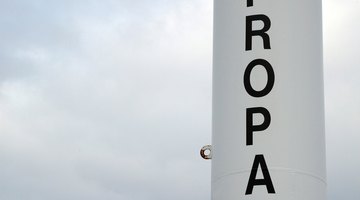Why Does Water Form Outside a Propane Tank?
Propane serves as fuel in a growing number of transportation fleets, and it's a common fuel for heating the home.

While the use of propane in vehicles and in home heating is not tremendously different from the use of natural gas and gasoline in the same applications, propane has properties that makes it store significantly colder than other fuels relevant to the surrounding atmosphere. For this reason, propane tanks regularly have water buildup on their outsides.
Temperature
Condensation sometimes forms on the outside of a propane tank due to the differences in temperature between the propane inside the tank and the surrounding air on the outside of the tank. When you extract propane gas from the tank, the liquid propane turns into a vapor that cools very rapidly. If the surrounding air is sufficiently different in temperature, the end result is condensation on the tank. This is similar to the manner in which condensation forms on the outside of a glass of ice water or tea when the ambient temperature is moderate.
Regulators
On some occasions the transfer of propane from liquid to vapor will occur so quickly that the regulator valve will freeze up or at least gather condensation on the outside. The process here is the same as that of condensation gathered on the outside of the propane tank. However, because of the proximity to the propane vapor, which is much colder than the liquid, the condensation will often turn into frost crystals. This too is part of the natural propane transfer process.
Amount
The amount of propane in the tank affects the amount of condensation on the outside of the tank. Generally speaking, propane tanks will gather more condensation on the outside when the tank contains greater levels of propane liquid. The reason for this is simple: Propane liquid on the inside of a tank gathers heat from the outside, causing condensation on the outside. Therefore, the greater the level of liquid in the tank, the more condensation will occur. In other words, a high level of propane will result in a higher level of condensation.
Avoidance
It is possible to avoid condensation buildup on the outside of a propane tank, although it is not necessary to do so in most cases. In instances where you may be camping and utilizing portable tanks in a limited space, condensation could feasibly become a problem for staying dry while you sleep, but in most cases propane condensation is normal and need not be avoided. To avoid excess condensation, place an interior propane tank near a dehumidifier or on a drain pan that will allow the condensation to run off and into a drain.
The Drip Cap
- Propane serves as fuel in a growing number of transportation fleets, and it's a common fuel for heating the home.
- Generally speaking, propane tanks will gather more condensation on the outside when the tank contains greater levels of propane liquid.
- The reason for this is simple: Propane liquid on the inside of a tank gathers heat from the outside, causing condensation on the outside.
References
Writer Bio
Jared Lewis is a professor of history, philosophy and the humanities. He has taught various courses in these fields since 2001. A former licensed financial adviser, he now works as a writer and has published numerous articles on education and business. He holds a bachelor's degree in history, a master's degree in theology and has completed doctoral work in American history.
Photo Credits
- Jupiterimages/Photos.com/Getty Images
- Jupiterimages/Photos.com/Getty Images
More Articles



